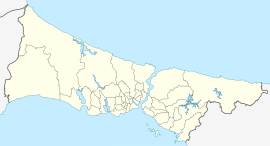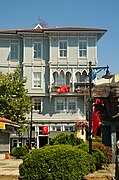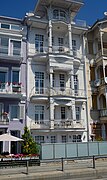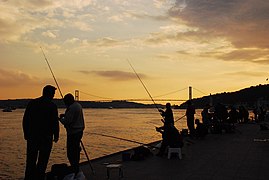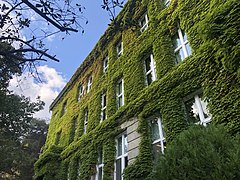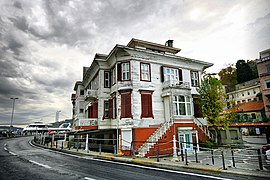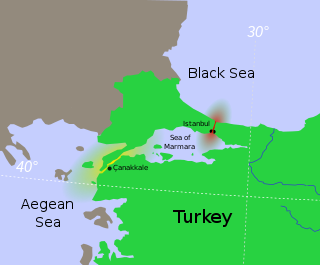
The Bosporus or Bosphorus Strait is a natural strait and an internationally significant waterway located in Istanbul in northwestern Turkey that connects the Black Sea to the Sea of Marmara. It forms part of the continental boundary between Asia and Europe, and divides Turkey by separating Anatolia from Thrace. It is the world's narrowest strait used for international navigation.

Anadoluhisarı, known historically as Güzelce Hisar is a medieval Ottoman fortress located in Istanbul, Turkey on the Anatolian (Asian) side of the Bosporus. The complex is the oldest surviving Turkish architectural structure built in Istanbul, and further gives its name to the neighborhood around it in the city's Beykoz district.

Üsküdar is a municipality and district of Istanbul Province, Turkey. Its area is 35 km2, and its population is 524,452 (2022). It is a large and densely populated district on the Anatolian (Asian) shore of the Bosphorus. It is bordered to the north by Beykoz, to the east by Ümraniye, to the southeast by Ataşehir and to the south by Kadıköy; with Karaköy, Kabataş, Beşiktaş, and the historic city center of Fatih facing it on the opposite shore to the west. Üsküdar has been a conservative cultural center of the Anatolian side of Istanbul since Ottoman times with its numerous historic landmark and little mosques and dergahs.

Beşiktaş is a district and municipality of Istanbul Province, Turkey. Its area is 18 km2, and its population is 175,190 (2022). It is located on the European shore of the Bosphorus strait. It is bordered on the north by Sarıyer and Şişli, on the west by Kağıthane and Şişli, on the south by Beyoğlu, and on the east by the Bosphorus. Directly across the Bosphorus is the district of Üsküdar.

Ortaköy is a neighbourhood in the municipality and district of Beşiktaş, Istanbul Province, Turkey. Its population is 9,423 (2022). It is on the European shore of the Bosphorus. it was originally a small fishing village, known in Greek as Agios Fokas in the Byzantine period and then as Mesachorion.

Kadıköy, known in classical antiquity and during the Roman and Byzantine eras as Chalcedon, is a municipality and district of Istanbul Province, Turkey. Its area is 25 km2, and its population is 483,064 (2022). It is a large, populous, and cosmopolitan area in the Asian side of Istanbul, on the northern shore of the Sea of Marmara. It partially faces the historic city centre of Fatih on the European side of the Bosporus. One of the most expensive neighborhoods in Istanbul, Kadıköy is also the name of the most prominent neighbourhoods of the district, a residential and commercial area that, with its numerous bars, cinemas and bookshops, is the liberal cultural centre of the Anatolian side of Istanbul. Kadıköy became a district in 1928 when it was separated from Üsküdar district. The neighbourhoods of Bostancı and Suadiye were also separated from the district of Kartal in the same year, and eventually joined the newly formed district of Kadıköy. Its neighbouring districts are Üsküdar to the northwest, Ataşehir to the northeast, Maltepe to the southeast, and Kartal beyond Maltepe.
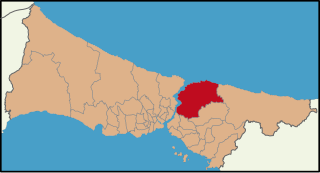
Beykoz, also known as Beicos and Beikos, is a municipality and district of Istanbul Province, Turkey. Its area is 310 km2, and its population is 247,875 (2022). It lies at the northern end of the Bosphorus on the Anatolian side. The name is believed to be a combination of the words bey and kos, which means "village" in Farsi. Beykoz includes an area from the streams of Küçüksu and Göksu to the opening of the Bosphorus into the Black Sea, and the villages in the hinterland as far as the Riva creek. The mayor is Murat Aydın (AKP).

Sarıyer is a municipality and district of Istanbul Province, Turkey. Its area is 177 km2, and its population is 350,454 (2022). It is on the northeastern part of Istanbul's European side. Sarıyer also administers the Black Sea coast to the west of the mouth of the Bosphorus, including the neighbourhood of Kilyos. It borders Eyüpsultan to the northwest, Beşiktaş to the south and Kağıthane to the west. The mayor is Şükrü Genç of the Republican People's Party (CHP).

The American Robert College of Istanbul, often abbreviated as Robert or RC, is a highly selective, independent, co-educational, private high school in Turkey. The school is situated in a 65-acre (26 ha) wooded campus on the European side of Istanbul in the Beşiktaş district, with the historic Arnavutköy neighborhood to the east and the upscale Ulus neighborhood to the west. Founded in 1863, Robert College is the oldest continuously operating American school outside the United States.
Boğaziçi is the general term, specific to Istanbul and overlapping administrative divisions, used to denote those parts of the city with a view of the Bosphorus. The respective nuances of the two terms being somewhat similar to those between San Francisco Bay and the Bay Area, they are not used interchangeably in correct parlance.

Kuzguncuk is a neighbourhood in the municipality and district of Üsküdar, Istanbul Province, Turkey. Its population is 4,151 (2022). It is on the Asian side of the Bosphorus. The neighborhood is centered on a valley opening to the Bosphorus and is somewhat isolated from the main part of the city, being surrounded by nature preserves, cemeteries, and a military installation. It is a quiet neighborhood with streets lined with antique Ottoman wooden houses.

Bebek is a neighbourhood in the municipality and district of Beşiktaş, Istanbul Province, Turkey. Its population is 5,464 (2022). It is an affluent neighbourhood located on Bebek Bay on the European shore of the Bosphorus strait. It is flanked by similarly affluent neighbourhoods such as Arnavutköy and Rumelihisarı.

Çengelköy is a neighbourhood in the municipality and district of Üsküdar, Istanbul Province, Turkey. Its population is 13,801 (2022). It is on the Asian shore of the Bosphorus strait, between the neighborhoods of Beylerbeyi and Kuleli. It is mainly a residential district. Many mansions were built there in the Ottoman period. There is a Greek church called Aya Yorgi in the district, which is not used much today. Abdullah Ağa Mansion and Sadullah Pasha Mansion are important mansions in Çengelköy.
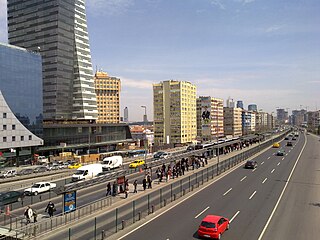
Mecidiyeköy is a neighbourhood in the municipality and district of Şişli, Istanbul Province, Turkey. Its population is 20,006 (2022). It is a heavily built-up residential and business neighbourhood, squeezed in between the Fulya, Kuştepe, Gültepe, Esentepe, and Gülbahar neighbourhoods.
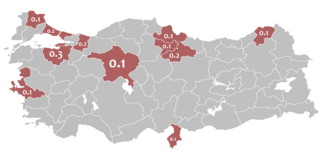
Albanians in Turkey are ethnic Albanian citizens and denizens of Turkey. They consist of Albanians who arrived during the Ottoman period, Kosovar/Macedonian and Tosk Cham Albanians fleeing from Serbian and Greek persecution after the beginning of the Balkan Wars, alongside some Albanians from Montenegro and Albania proper. A 2008 report from the Turkish National Security Council (MGK) estimated that approximately 1.3 million people of Albanian ancestry live in Turkey, and more than 500,000 recognizing their ancestry, language and culture. There are other estimates however that place the number of people in Turkey with Albanian ancestry and background upward to 5 million. Albanian Veterans who once served in 21st Waffen Mountain Division of the SS Skanderbeg immigrated with their families from Yugoslavia to Turkey in 1953-1968.

Emirgan is a neighbourhood in the municipality and district of Sarıyer, Istanbul Province, Turkey. Its population is 8,290 (2022). It is a leafy, middle-class suburb of Istanbul, on the western shore of the Bosphorus north of the Fatih Sultan Mehmet Bridge.

Kuruçeşme is a neighbourhood in the municipality and district of Beşiktaş, Istanbul Province, Turkey. Its population is 2,846 (2022). It is on the European side of the Bosphorus between the neighbourhoods of Ortaköy and Arnavutköy.
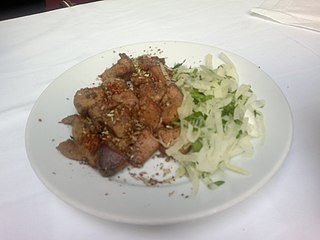
Arnavut ciğeri is a Turkish dish made of oil-fried lamb or veal liver cubes seasoned with hot pepper, served traditionally with onion and parsley.

The following outline is provided as an overview of and topical guide to Istanbul:
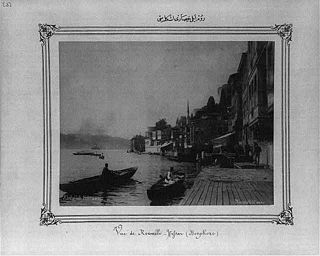
Rumelihisarı is a neighbourhood in the municipality and district of Sarıyer, Istanbul Province, Turkey. Its population is 10,073 (2022). It is on the European side of Istanbul. The neighborhood is famous for and named after its medieval fortress, Rumelihisarı, built by Mehmed the Conqueror between 1451 and 1452 CE.


